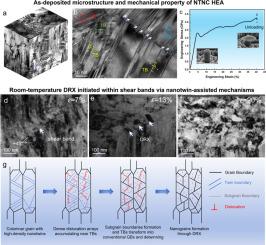Nanotwin-assisted dynamic recrystallization achieves high strength and ductility in nanocrystalline CrMnFeCoNi high entropy alloy
IF 14.3
1区 材料科学
Q1 MATERIALS SCIENCE, MULTIDISCIPLINARY
引用次数: 0
Abstract
Nanocrystalline (NC) high entropy alloys (HEAs) possess superior strength but often exhibit poor ductility due to suppressed dislocation activity and limited strain hardening. Dynamic recrystallization (DRX) has been recognized as an effective mechanism to improve plasticity and strength in coarse-grained materials. However, its activation in NC HEAs at room temperature is typically constrained by insufficient thermal activation and the requirement for extremely high local strains. In this work, a high density of pre-existing nanotwins was introduced into NC CrMnFeCoNi HEA to facilitate DRX through a nanotwin-assisted dynamic recrystallization (ntDRX) mechanism during deformation. The alloy, fabricated by magnetron sputtering, exhibits a single-phase face-centered cubic (FCC) structure with columnar grains of approximately 60 nm. Micropillar compression tests demonstrate a high yield strength of 2.3 GPa and a compressive strain exceeding 40%. During deformation, in addition to dislocation slip and grain boundary (GB) activities, DRX is activated within shear bands, leading to the formation of equiaxed nanograins. These newly formed grains increase interface density, impede dislocation motion, and elevate the flow stress to 2.75 GPa. Additionally, the newly formed GBs of equiaxed grains facilitate GB-mediated deformation at large strains, improving plasticity and suppressing shear localization. Furthermore, tensile experiments reveal two interconnected ntDRX mechanisms. One involves dislocation accumulation at twin boundaries (TBs) leading to subgrain formation through dislocation rearrangement and its evolution into high-angle grain boundaries (HAGBs), while the other involves the direct transformation of coherent TBs into HAGBs through dislocation interactions. This study advances the understanding of room-temperature DRX in NC HEAs and highlights nanotwin engineering as a promising strategy for optimizing mechanical performance.

纳米孪晶辅助动态再结晶使纳米晶crmnnfeconi高熵合金具有较高的强度和延展性
纳米晶(NC)高熵合金(HEAs)具有优异的强度,但由于位错活性受到抑制和有限的应变硬化,往往表现出较差的塑性。动态再结晶(DRX)是提高粗晶材料塑性和强度的有效机制。然而,它在室温下在NC HEAs中的激活通常受到热激活不足和对极高局部应变要求的限制。在这项工作中,将高密度的纳米孪晶引入到NC CrMnFeCoNi HEA中,通过纳米孪晶辅助动态再结晶(ntDRX)机制促进变形过程中的DRX。该合金采用磁控溅射法制备,具有约60 nm柱状晶粒的单相面心立方(FCC)结构。微柱压缩试验表明,其屈服强度高达2.3 GPa,压缩应变超过40%。变形过程中,除了位错滑移和晶界(GB)活动外,DRX在剪切带内被激活,导致等轴纳米晶粒的形成。这些新形成的晶粒增加了界面密度,阻碍了位错运动,使流动应力提高到2.75 GPa。此外,等轴晶粒新形成的gb有利于大应变下gb介导的变形,提高塑性并抑制剪切局部化。此外,拉伸实验揭示了两种相互关联的ntDRX机制。一种是位错在孪晶界积聚,通过位错重排形成亚晶并演化为高角度晶界,另一种是位错相互作用使共格晶界直接转变为高角度晶界。本研究促进了对室温DRX在数控HEAs中的理解,并强调纳米孪晶工程是优化机械性能的一种有前途的策略。
本文章由计算机程序翻译,如有差异,请以英文原文为准。
求助全文
约1分钟内获得全文
求助全文
来源期刊

Journal of Materials Science & Technology
工程技术-材料科学:综合
CiteScore
20.00
自引率
11.00%
发文量
995
审稿时长
13 days
期刊介绍:
Journal of Materials Science & Technology strives to promote global collaboration in the field of materials science and technology. It primarily publishes original research papers, invited review articles, letters, research notes, and summaries of scientific achievements. The journal covers a wide range of materials science and technology topics, including metallic materials, inorganic nonmetallic materials, and composite materials.
 求助内容:
求助内容: 应助结果提醒方式:
应助结果提醒方式:


